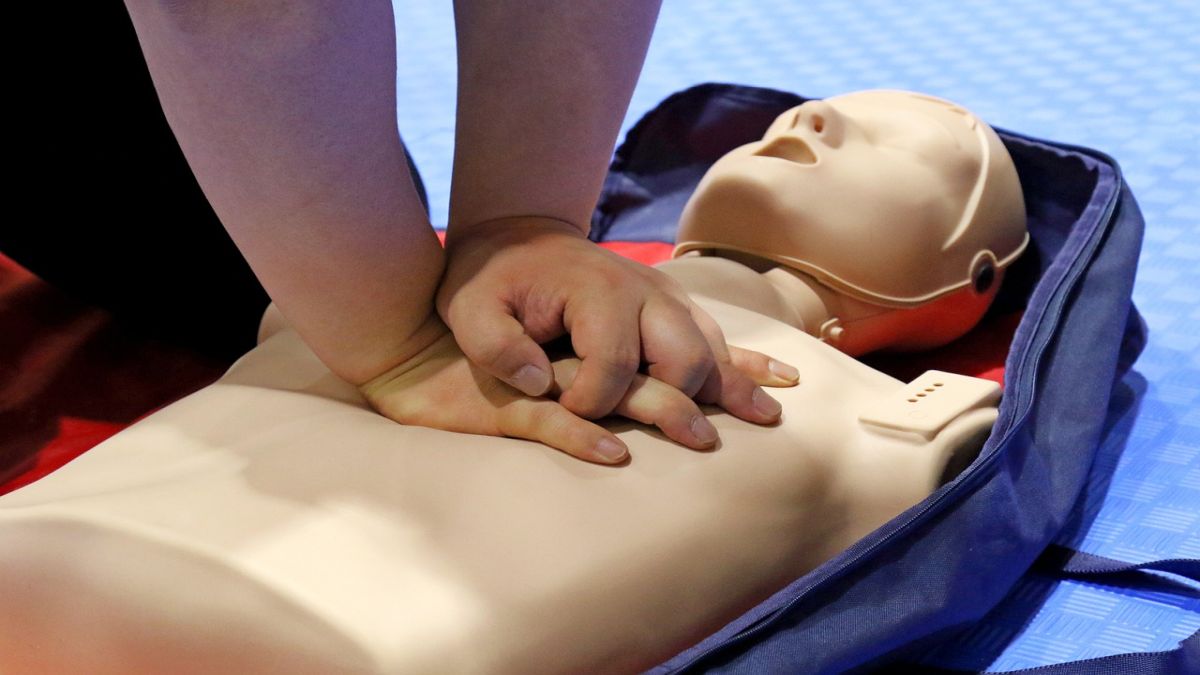Recently, a video went viral on social media in which a railway ticket examiner administered Cardiopulmonary Resuscitation (CPR) and saved a man’s life on a long-distance train between Bihar’s Darbhanga and Uttar Pradesh’s Varanasi.
Social media users praised the Railways official for his quick thinking and preparedness to tackle the medical emergency.
The incident has once again thrown light on the life-saving skill of CPR.
On World Heart Day, celebrated each year on September 29, we take a closer look at this exercise and how it can help save lives.
CPR, explained
Cardiopulmonary resuscitation is a way to help save someone when they are suffering from cardiac arrest by attempting to restart their heart through compressions. The aim of CPR is to the flow of blood and oxygen through the body when a person’s heart and breathing have stopped.
There are two types of CPR performed — hands-only CPR, which involves pushing on the chest in quick successive movements, also known as chest compressions. The other type of CPR is traditional CPR with breaths in which chest compressions are coupled with mouth-to-mouth breaths. This type of CPR can give the body more oxygen in the critical moments before help arrives.
Medical experts note that CPR is performed differently for people based on whether the individual is an adult, a child or an infant. In the case of an adult, chest compressions are done with two hands, whereas for children, it’s done with one hand. For infants, CPR is performed with either thumbs or fingers.
Delivering CPR
In a time of an emergency, CPR should be performed keeping these steps in mind. The very first step in delivering CPR is calling the emergency helpline and asking for medical attention.
Once aid has been asked for, the individual should be carefully placed on their back and kneel beside their chest. To perform the chest compressions, depending on the patient, with the heel of the hands and straight elbows, push hard and fast in the centre of the chest, slightly below the nipples.
First-aid responders and cardiologists say that to perform effective CPR, one should push at least two inches deep and at a rate of at least 100 times per minute. Moreover, let the chest rise fully between compressions.
The American Heart Association asks people to remember the song Stayin’ Alive by the Bee Gees or Shakira’s Hips Don’t Lie to time their compressions.
Time matters
One should only deliver CPR when a person is not breathing. For children and infants, CPR is only delivered when they aren’t breathing normally. Hence, experts note that it is of utmost importance that when a person is about to deliver CPR, they ask the patient to respond to verbal calls.
Importance of CPR
Doctors are of the opinion that when performed correctly, CPR can help save lives. The American Heart Association notes that CPR can double or triple the chances of survival after cardiac arrest.
A study published in early February revealed that a person who is administered CPR within a minute of cardiac arrest has 22 per cent chance of survival, while one who gets it after 39 minutes has only one per cent probability.
Dr Rakesh Garg, scientific director, Indian Resuscitation Council was quoted as telling the New Indian Express, “If we talk about data, then almost 80 to 82 per cent cardiac arrest happens outside hospital. With each minute the chances of survival decrease by seven to 10 minutes. If we don’t immediately give CPR, the patient will have a brain injury. In some countries, with increasing practice of CPR, it has been found that 40-60 per cent of people could be saved. Since time is important, any layman can manually start a heart with a skill which can be learned with a practice of five-10 minutes and can save a life.”
And this is why doctors believe that at a time when the world is witnessing a huge spike in heart cases, it is important that people learn the skill of CPR. They also note that only when administered correctly does it help; if CPR is delivered incorrectly, it can lead to fractured or cracked ribs as well as pulmonary haemorrhage, liver lacerations, and broken sternums.
India’s unhealthy hearts
Knowing CPR assumes even more significance in a country like India, where the burden of heart disease is high. Moreover, CPR awareness in the country continues to remain low. In 2021, it was reported that less than two per cent of India’s population knew CPR.
India’s heart health is also a huge concern. According to the World Health Organization, the country accounts for one-fifth of all cardiovascular diseases, especially in the younger population. The results of a Global Burden of Disease study state an age-standardised CVD death rate of 272 per one lakh population in India, which is much higher than the global average of 235.
The data from the National Crime Records Bureau also paints a grim picture for the country. It reveals that deaths due to cardiac arrests saw a 12.5 per cent rise, from 28,413 in 2021 to 32,457 in 2022.
Doctors consistently link sedentary lifestyles, high-stress jobs as the leading reasons for India’s young hearts suffering. They state that sitting for long hours and working at high-pressure jobs is putting immense stress on people’s hearts, resulting in various cardiovascular diseases.
Additionally, the existence of co-morbidities in young Indians is also causing a rise in cardiac events. Experts note that the presence of conditions like diabetes, hypertension and obesity , makes individuals even more susceptible to heart conditions.
Some even note that genetic predisposition and unhealthy diets are other culprits in this situation. Furthermore, bad habits such as smoking and excessive alcohol consumption further expose young Indians to heart attack risks.
In such circumstances, it is paramount that we learn CPR and help save a lifewhen needed.
With inputs from agencies


)

)
)
)
)
)
)
)
)



